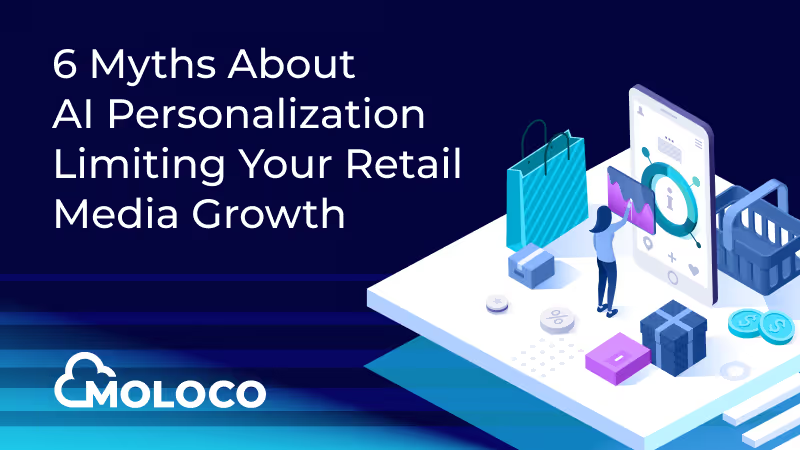Blog Article
Retail media is the fastest-growing sector of digital advertising, with ad spend volumes rising more than 20 percent year over year. As retail media networks (RMNs) gain prominence, misconceptions are emerging that could hinder the potential for long-term success. Two widespread myths in particular are creating confusion for retailers looking to scale their ad businesses:
Both of these beliefs overlook the true value and unique position of RMNs. Rather than relying on third-party solutions, RMNs can take control of their own advertising ecosystems — leveraging advanced technology and machine learning to unlock growth, enhance relevance, and build stronger direct relationships with their advertisers.
One popular but misguided approach is the creation of a retail media supply-side platform (SSP), where RMNs manage multiple demand sources to boost revenue. Let’s explore what this looks like and why it doesn’t deliver the scale or performance RMNs truly need.
A common solution proposed for “bringing demand” is the creation of a retail media supply-side platform (SSP), which promises to manage multiple demand sources and boost revenue. At first glance, this approach seems appealing, but let’s break down how it actually works — and why it doesn’t fully deliver for RMNs looking to scale.
Here’s how a retail media SSP functions:
For the RMN/Publisher:
For the advertiser:
This focus on “bringing demand” is why many retail media networks turn to platforms like GAM or Criteo, as demand is often seen as their primary value proposition.. The problem: this won’t meaningfully grow your business.
While SSPs offer some benefits, they come with several drawbacks that prevent RMNs from truly scaling. Beyond disintermediating retailers from their brand relationships and adding demand-side fees that hinder performance, here are additional reasons SSPs fall short:
The limitations of retail media SSPs are clear — they fail to improve inventory performance, shift the risk onto advertisers, and lead to underutilized budgets. To truly scale, RMNs must go beyond simply sourcing demand. Instead, they need to harness their unique strengths, like first-party data and real-time user behavior, to drive relevance, performance, and growth.
This is where machine learning and purpose-built ad tech solutions come into play.
It’s important to understand, SSPs solved a problem in digital advertising at a much larger scale than retail media by enabling real-time bidding across hundreds of thousands of publishers. The dynamics in retail media are unique. For most advertisers, only 10 to 20 RMNs are likely to be of real significance.
Retail media networks aren’t just another publisher — in fact, they are customers of endemic advertisers. These networks should be seen as mini walled gardens, more aligned with the models of Amazon, Meta, and Google than with open internet publishers. RMNs have distinct advantages: inventory close to the point of transaction, the best first-party data in advertising, and built-in relationships with brands already selling through their platforms.
To fully capitalize on these strengths, RMNs should follow the playbook used by Amazon, Meta, and Google, who dominate 65% of digital marketing by focusing on:
A retail media SSP alone won’t bridge these gaps. What RMNs truly need is a purpose-built, machine learning-driven partner. like Moloco that solves all three. By maximizing the predictive power of first-party data, Moloco empowers retailers to take control of their ad ecosystem and unlock sustainable growth.
.avif) Beyond Last-Click: How We Prove Incremental ROAS in Retail Media
Beyond Last-Click: How We Prove Incremental ROAS in Retail MediaGhost bidding reveals true retail media ROI. See how AI-native incrementality testing delivers proven results from 253% to 1,609% incremental ROAS.

 6 Myths About AI Personalization Limiting Your Retail Media Growth
6 Myths About AI Personalization Limiting Your Retail Media GrowthDiscover the truth behind 6 AI personalization myths that are holding back your retail media growth - and how to maximize your performance.

.avif) The Commerce Media Ecosystem: Where Data, AI, and Ecommerce Shopping Converge
The Commerce Media Ecosystem: Where Data, AI, and Ecommerce Shopping ConvergeEverything you want to know about the Commerce Media Ecosystem. Learn how first-party data and AI is used to drive growth for suppliers, digital retailers, and consumers.

.avif) Moloco appoints Ned Samuelson as new Global Head of Business, Moloco Commerce Media
Moloco appoints Ned Samuelson as new Global Head of Business, Moloco Commerce MediaNed Samuelson has joined Moloco as the Global Head of Business for Moloco Commerce Media, where he will lead global growth efforts, focusing on expanding retail business and optimizing commerce advertising. With over 12 years of experience at Criteo, Ned brings a proven track record of driving measurable growth across diverse industries and will help retailers and marketplaces unlock new revenue using Moloco’s AI-powered platform.

